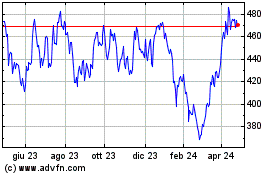Glencore Sees Benefit From Growing Electric Vehicle Demand -- Commodity Comment
21 Febbraio 2018 - 4:51PM
Dow Jones News
By David Hodari
Global mining giant Glencore reported its 2017 annual results
Wednesday, more than quadrupling its full-year net income to $5.8
billion, revealing a dividend of $0.20 a share. Here are remarks on
metals from the company's earnings report:
On its operating environment:
"...positive momentum continued through 2017, resulting in
prolonged outperformance of Glencore's key commodities versus the
broader markets. Concerns of tightening financial conditions in
China during the second quarter proved to be short-lived, with
commodities rallying once again through the second half of the
year. Strong economic performance in both major developing and
developed markets has underpinned supportive commodity demand
conditions. The electric vehicle upheaval continues to unfold, with
the scale of market penetration and investment, by battery and
automotive manufacturers and infrastructure players, adjusting
progressively upwards..."
On electric vehicles:
"Accelerating electric-vehicle adoption requires an energy and
mobility transformation that is forecast to unlock material new
sources of demand for the enabling underlying commodities including
copper, nickel and cobalt. We recently commissioned an independent
study to gauge the potential incremental demand for these
commodities under the Electric Vehicles Initiative scenario of 30%
electric vehicle market share by 2030. The findings suggest an
additional 4.1 million tons of copper, 1.1 million tons of nickel
and 314,000 tons of cobalt supply will be required by 2030. These
potentially significant new demand sources offer compelling
fundamentals, particularly when coupled with persistent supply
challenges."
On copper:
"In 2017, the copper price [increased] 27% year-over-year. The
rally was most apparent in the second half, with a 2017 high of
$7,254/t in late December marking levels last seen in early 2014.
Over the year, synchronised global growth fuelled healthy demand in
major copper consuming regions. Mine supply challenges continued to
exceed market expectations, resulting in a c.2% contraction in
mined volumes year-on-year, the first decline in over 15 years.
Copper scrap flows played an important role in the first half of
the year, as higher prices triggered the release of stockpiled
scrap into the market and contributed to a short period of apparent
demand weakness. Combined with misplaced fears of tightening
financial conditions in China, this resulted in a temporary
pullback in the price rally. Copper scrap inventory reverted to
normalised levels by mid-year, with drawdowns in copper units
across the value chain through to year-end.
...the copper market is likely to remain in substantial supply
deficit, which, if it occurs, will in turn result in further
inventory drawdowns."
On zinc:
"In 2017, the zinc price recorded a 38% year-over-year
increase... Going forward, higher prices will incentivize higher
concentrate production, easing TCs in the mid-term and eventually
resulting in higher metal production. However, the environmental
constraints in China and the slower-than-anticipated pace of mine
restarts (or new mines) means that the current zinc tightness may
remain for some time. As there is also a time lag before
concentrates units convert into metal units, we expect the current
strong pricing environment to be supported in the near to
mid-term."
On nickel:
In 2017, a record supply deficit was evident in the nickel
market, as strong synchronised demand growth across all regions and
industry segments offset supply gains. Such positive fundamentals,
backed by strong physical activity and significant draws in global
inventory, drove nickel premiums to record highs... Consequently,
the nickel market remained in material supply deficit for a second
year running, enabling global stocks to draw down quickly despite
headline LME inventory suggesting otherwise. Even with a
conservative forecast for 2018 demand, the outlook is for continued
sizeable deficits and further draws in primary nickel stocks.
Forecast supply increases are based on Indonesia exporting more
nickel units in ore or NPI, with production elsewhere expected to
be flat or fall."
On agricultural commodities markets:
"The grain and oilseed markets were again well supplied, low
priced and lacked volatility, which in turn limited arbitrage
opportunities. Despite a brief U.S. weather concern in late June,
impacting primarily spring wheat, which proved to be less
significant than initially thought, global crops were problem free
with Russia, Australia (basis late 2016 harvest carried over) and
Brazil all recording historically high production."
Write to David Hodari at david.hodari@wsj.com
(END) Dow Jones Newswires
February 21, 2018 10:36 ET (15:36 GMT)
Copyright (c) 2018 Dow Jones & Company, Inc.
Grafico Azioni Glencore (LSE:GLEN)
Storico
Da Mar 2024 a Apr 2024

Grafico Azioni Glencore (LSE:GLEN)
Storico
Da Apr 2023 a Apr 2024
